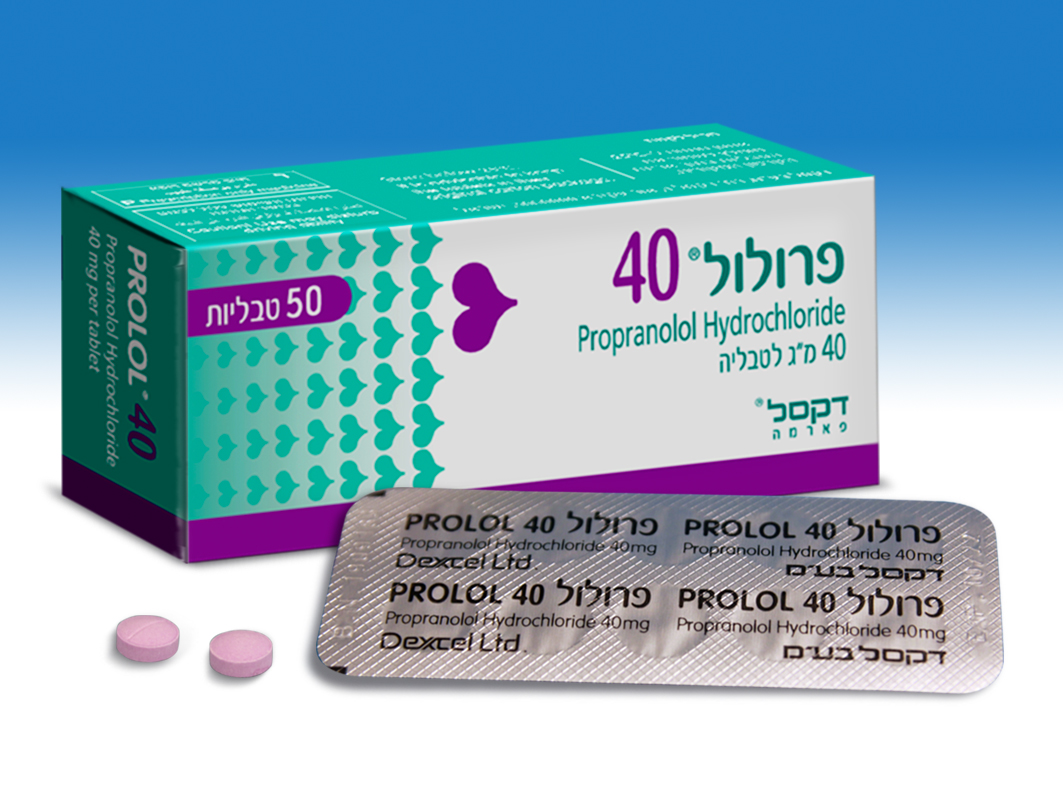Quest for the right Drug

פרולול 40 PROLOL 40 (PROPRANOLOL HYDROCHLORIDE)
תרופה במרשם
תרופה בסל
נרקוטיקה
ציטוטוקסיקה
צורת מתן:
פומי : PER OS
צורת מינון:
טבליה : TABLETS
עלון לרופא
מינוניםPosology התוויות
Indications תופעות לוואי
Adverse reactions התוויות נגד
Contraindications אינטראקציות
Interactions מינון יתר
Overdose הריון/הנקה
Pregnancy & Lactation אוכלוסיות מיוחדות
Special populations תכונות פרמקולוגיות
Pharmacological properties מידע רוקחי
Pharmaceutical particulars אזהרת שימוש
Special Warning עלון לרופא
Physicians Leaflet
Special Warning : אזהרת שימוש
4.4 Special warnings and precautions for use Propranolol as with other beta-blockers: - although contraindicated in uncontrolled heart failure (see section 4.3), may be used in patients whose signs of heart failure have been controlled. Caution must be exercised in patients whose cardiac reserve is poor. - should not be used in combination with calcium channel blockers with negative inotropic effects (e.g. verapamil, diltiazem), as it can lead to an exaggeration of these effects particularly in patients with impaired ventricular function and/or SA or AV conduction abnormalities. This may result in severe hypotension, bradycardia and cardiac failure. Neither the beta-blocker nor the calcium channel blocker should be administered intravenously within 48 hours of discontinuing the other. - although contraindicated in severe peripheral arterial circulatory disturbances (see section 4.3), may also aggravate less severe peripheral arterial circulatory disturbances. - due to its negative effect on conduction time, caution must be exercised if it is given to patients with first degree heart block. - may block/modify the signs and symptoms of the hypoglycaemia (especially tachycardia). Propranolol occasionally causes hypoglycaemia, even in non-diabetic patients, e.g. neonates, infants, children, elderly patients, patients on haemodialysis or patients suffering from chronic liver disease and patients suffering from overdose. Severe hypoglycaemia associated with propranolol has rarely presented with seizures and/or coma in isolated patients. Caution must be exercised in the concurrent use of propranolol and hypoglycaemic therapy in diabetic patients. propranolol may prolong the hypoglycaemic response to insulin (see section 4.3). - may mask the signs of thyrotoxicosis. - should not be used in untreated phaeochromocytoma. However, in patients with phaeochromocytoma, an alpha-blocker may be given concomitantly. - will reduce heart rate as a result of its pharmacological action. In the rare instances when a treated patient develops symptoms which may be attributable to a slow heart rate, the dose may be reduced. - may cause a more severe reaction to a variety of allergens when given to patients with a history of anaphylactic reaction to such allergens. Such patients may be unresponsive to the usual doses of adrenaline used to treat the allergic reactions. Abrupt withdrawal of beta-blockers is to be avoided. The dosage should be withdrawn gradually over a period of 7 to 14 days. Patients should be followed during withdrawal especially those with ischaemic heart disease. When a patient is scheduled for surgery and a decision is made to discontinue beta- blocker therapy, this should be done at least 24 hours prior to the procedure. The risk/benefit of stopping beta blockade should be made for each patient. Since the half-life may be increased in patients with significant hepatic or renal impairment, caution must be exercised when starting treatment and selecting the initial dose. Propranolol must be used with caution in patients with decompensated cirrhosis (see section 4.2). In patients with portal hypertension, liver function may deteriorate and hepatic encephalopathy may develop. There have been reports suggesting that treatment with propranolol may increase the risk of developing hepatic encephalopathy (see section 4.2). Interference with laboratory tests: propranolol has been reported to interfere with the estimation of serum bilirubin by the diazo method and with the determination of catecholamines by methods using fluorescence. Prolol tablets contain lactose. Patients with rare hereditary problems of galactose intolerance, total lactase deficiency or glucose-galactose malabsorption should not take this medicine. Prolol 10 contains orange lake E-110, which may cause allergic reactions.
Effects on Driving
4.7 Effects on ability to drive and use machines Propranolol has no or negligible influence on the ability to drive and use machines. However it should be taken into account that occasionally dizziness or fatigue may occur.

פרטי מסגרת הכללה בסל
התרופה תינתן לטיפול במקרים האלה:א. יתר לחץ דםב. תעוקת חזה (angina pectoris)ג. טכיקרדיה סופרא ונטריקולרית (supraventricular tachycardia)ד. פרפור פרוזדורים (Atrial fibrillation)ה. רפרוף פרוזדורים (Atrial flutter)ו. הפרעת קצב על רקע שימוש בדיגיטאליס (digitalis induced arrhythmia)ז. קרדיומיופתיה היפרטרופית חסימתית (hypertrophic obstructive cardiomyopathy)ח. לאחר אוטם שריר הלב (post myocardial infarction)ט. היפרתירואידיזםי. רעד ראשוני (essential tremor)יא. מיגרנהיב. פיאוכרומוציטומהיג. מניעת אירועים היפוקסיים (hypoxic spells) בילדים הלוקים ב-Tetralogy of Fallot
שימוש לפי פנקס קופ''ח כללית 1994
Hypertension, angina pectoris, supraventricular tachycardia, atrial fibrillation and flutter, digitalis induced arrhythmia, hypertrophic obstructive cardiomyopathy, post myocardial infarction, hyperthyroidism, essential tremor, migraine, pheochromocytoma. Children: prevention of hypoxic spells in Tetralogy of Fallot
תאריך הכללה מקורי בסל
01/01/1995
הגבלות
תרופה שאושרה לשימוש כללי בקופ'ח
מידע נוסף
